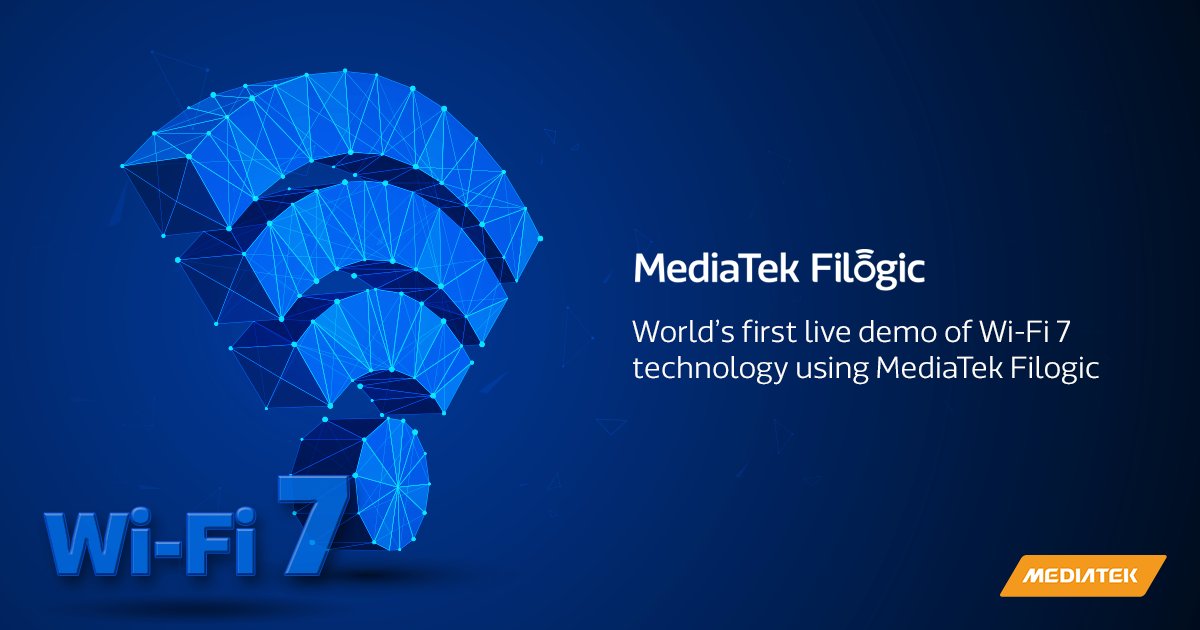
MediaTek has conducted the world's first live demo of Wi-Fi 7 for "key customers and industry collaborators," paving the way for the wireless network technology to enter mainstream consumer hardware as early as next year, according to the company.

Taiwan-based MediaTek said the demos demonstrated the ability of Wi-Fi 7 to achieve the maximum speed defined by IEEE 802.11be, the official name for the Wi-Fi 7 standard. The company said it also highlighted its multi-link operation (MLO) technology. MLO aggregates multiple channels on different frequency bands at the same time to allow network traffic to still flow seamlessly even if there is interference or congestion on the bands. "Filogic" simply refers to MediaTek's Wi-Fi 7 connectivity portfolio.
Wi-Fi 7 is said to deliver 2.4x faster speeds than Wi-Fi 6, even with the same number of antennas, since Wi-Fi 7 can utilize 320Mhz channels and supports 4K quadrature amplitude modulation (QAM) technology."The rollout of Wi-Fi 7 will mark the first time that Wi-Fi can be a true wireline/Ethernet replacement for super high-bandwidth applications," said Alan Hsu, corporate vice president and general manager of the Intelligent Connectivity business at MediaTek. "MediaTek’s Wi-Fi 7 technology will be the backbone of home, office and industrial networks and provide seamless connectivity for everything from multi-player AR/VR applications to cloud gaming and 4K calls to 8K streaming and beyond."
"Faster broadband Internet access and more demanding applications such as higher resolution video streaming and VR gaming are driving demand for Wi-Fi 6, Wi-Fi 6E, and soon Wi-Fi 7," said Mario Morales, group vice president, Semiconductors at IDC. "Wi-Fi 7's advances in channel width, QAM, and new features such as multi-link operation (MLO) will make Wi-Fi 7 very attractive for devices including flagship smartphones, PCs, consumer devices and vertical industries like retail and industrial; as service providers begin to deploy a wider spectrum of hotspots across these market segments."
The Wi-FI Alliance says Wi-Fi 7 could provide speeds of "at least 30" gigabits per second (Gbps) and should exceed that to reach 40Gbps, which is the same speed as Thunderbolt 3. As noted by ArsTechnica, Wi-Fi 6 supports speeds up to 9.6Gbps, while its predecessor, WiFi 5, has a max output of 3.5Gbps. Wi-Fi 6 is the marketing name given to 802.11ax technology, which is supported by all iPhone 11 and later models, the newest iPad mini, iPad Air, iPad Pro, and all Macs powered by Apple silicon.
The next step up from Wi-Fi 6 is Wi-Fi 6E. Devices supporting Wi-Fi 6E use a dedicated 6E spectrum with up to seven additional 160MHz channels, while Wi-Fi 6 devices share the same spectrum as other Wi-Fi 4, 5, and 6 devices, and they only operate on two 160MHz channels. Some reports suggested Apple's iPhone 13 series would include Wi-Fi 6E, but the rumors never panned out. Looking ahead, this year's iPhone 14 is expected to adopt Wi-Fi 6E and Apple's forthcoming AR/VR headset is also expected to support it to meet the needs of the high-end, immersive experience it will deliver, according to analyst Ming-Chi Kuo.
MediaTek has been involved in the development of the Wi-Fi 7 standard since its inception and is eager to drum up excitement for its Wi-Fi 7 Filogic connectivity portfolio, but the protocol hasn't been finalized by the Wi-FI Alliance yet, so it's difficult to say when consumer devices will actually support it. MediaTek says products with Wi-Fi 7 are expected to hit the market starting in 2023. Regardless, given that Apple has yet to adopt Wi-Fi 6E in any of its devices, support for Wi-Fi 7 is likely to be some way away.
Article Link: MediaTek Demos Next-Gen Wi-Fi 7 Standard Boasting Near Thunderbolt 3 Speeds

